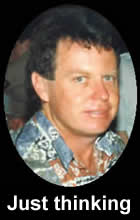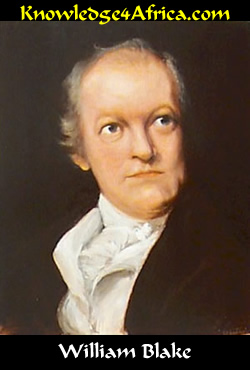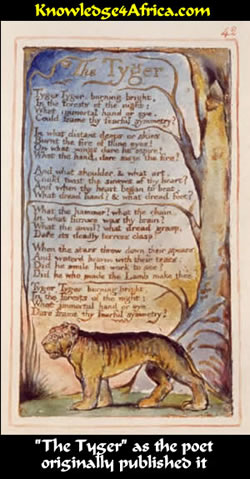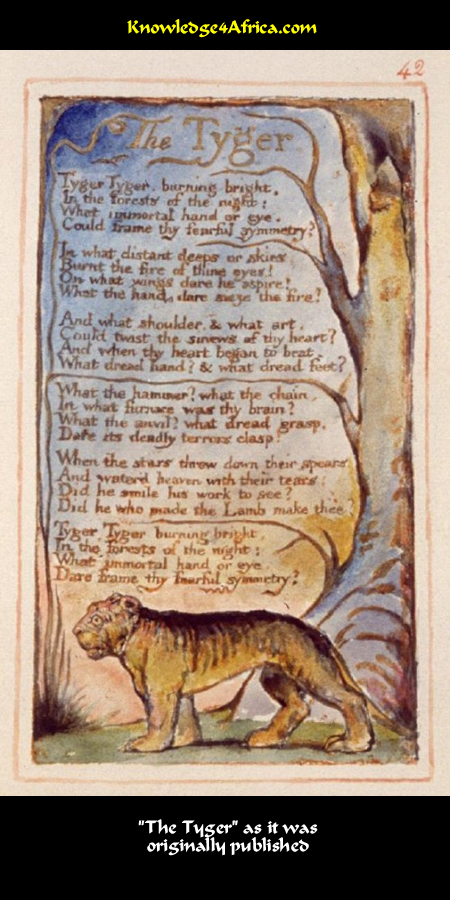|
READ THIS
The poet looks at the power and yet the terror of the tiger and asks questions about its creation.
He uses the image of God as a blacksmith, beating the tiger into existence in the same way as a
blacksmith beats metal into shape.
But, asks the poet, is this the same Creator God as the one who shaped the lamb? Indeed, is this the
same God as the one who is the Father of Jesus Christ?
 ABOUT THE POET
ABOUT THE POET
William Blake was born in London in November 1757. He lived most of his life in that city.
When he was 10 years of age, he attended a drawing school and thereafter made engraving his
profession, graduating from the Royal Academy at the age of 22.
He was then employed as an engraver to a bookseller and publisher, where he was responsible for
creating metal picture plates for making illustrations in books.
In 1783, Blake published his first volume of poems and thereafter established his own engraving business.
This enabled him to publish poetry in a way in which no other poet was doing: by incorporating his text
into engraved picture plates.
This would have remarkable consequences. First, the pictures were artistic renditions of the theme and
were not meant to be accurate. Second, each and every picture appeared in a slightly different shade of
colour so that it is difficult today to determine which colour was the original.
Move your mouse over the picture below to see an example of his engraving for "The Tyger".
Blake's best poems are found in just two collections: Songs of Innocence which he published in
1789; and Songs of Experience although this was not published on its own.
Indeed, his complete works was published in 1794 and was called Songs of Innocence and
Experience Shewing the Two Contrary States of the Human Soul.
Blake was regarded in his time as very strange, if not somewhat mad. In fact, his ideas make more sense
to us today than they did to his contemporaries.
He was a Christian but in a very unorthodox sense. Indeed, he appears to have been what we today call
a Gnostic Christian.
The Gnostics believed in the inner power of wisdom which guides us.
They also believed in two Gods. The first was the God who created material things: like the world, the
animals and humans. The second was the God who created the things of the spirit: like the human soul.
The first God is responsible for all the nasty things in life: like suffering and pollution and dreadful
industrialisation. The second God is responsible for all the wonderful things in life: like salvation, the
human spirit and, of course, Jesus Christ.
Study "The Tyger" carefully. Can you not see the existence of two Gods there? The one God
created the Tyger while the other created the Lamb.
At the time that Blake wrote "The Tyger", people knew very little about wild animals. Perhaps they
might have seen a lion in a circus but almost no-one would have seen a tiger.
A tiger therefore came to represent something to Blake, and it is this that he tries to portray in his poem,
"The Tyger".
But what is he trying to tell us? Is it, in the words of his anthology in which this poem was published,
something about "the Two Contrary States of the Human Soul"?
Blake died in August 1827. He was then 70 years of age.
Have you looked at the questions
in the right column?
|
TEST YOURSELF!
Read the left column and then answer
the following questions:
The entire poem focuses on the Creator God. But is this God presented in Christian terms?
Explain. (10)

[Need help?]
It is difficult to view the Creator God in "The Tyger" in purely Christian terms. Indeed, there would
appear to be overtones of a primeval or pagan deity.
The poet uses such words as "distant deeps or skies" and "the stars threw down their
spears", both of which would refer to mythical stories of ancient times, creation folklore that is certainly
not biblical.
It is possible too that Blake is referring to Gnosticism, a very early alternative form of Christianity that was
banished as heresy in the first centuries of the Christian Church.
In the Gnostic version of creation, there were the two "Demiurges", an evil one who created the
world and a good one who created the human spirit.
Blake, however, does not appear to accept the full Gnostic view which would see the Tyger as evil.
The Tyger in Blake's poem is rather something representing perhaps the darker side of the human spirit.
|
What image is consistently used throughout the poem to depict the Creator God? How does the poet
achieve this image through his choice of words and rhythm? (10)

[Need help?]
The Creator God is presented as a blacksmith, is he not?
The rhythm throughout the poem is one of stressed followed by unstressed syllables, creating the
effect of the blacksmith beating the anvil and thereby forging his creation out of steel.
There is also the reference to fire throughout the poem: "burning bright", "burnt the fires",
"seize the fire" and "furnace".
Then there are the references to the blacksmith's instruments: "the hammer", "the chain",
"the furnace" and "the anvil".
|
When Blake published "The Tyger" in 1794, few of his readers would actually have seen a tiger.
They were simply regarded as amazing beasts which existed in far away India. In fact, the poet himself
had probably never seen a real tiger except perhaps in the form of a floor rug in some elite household.
- Is Blake's description of the Tyger, therefore, real or imaginary? (10)

[Need help?]
What is real? What is imaginary?
Blake was essentially an artist. His Tyger is therefore a painting in words.
The Tyger in this poem is a rather magical, mystical creature, is it not? It is an artist's impression of the
animal -- almost an alien creature, with glowing eyes and stripes, muscles of steel, a heart that is twisted
like some machine and a brain that has been forged in a furnace.
Blake's readers would have been called upon to use their imaginations in perceiving this creature.
And they would have to have used their imaginations because, like Blake, none of them would ever have
seen a real tiger.
|
When Blake wrote "The Tyger", England was in the early stages of the Industrial Revolution. Is this
reflected in any way in this poem? (10)

[Need help?]
It can be argued that "The Tyger" is indeed a product of the Industrial Revolution.
Blake does not focus on the beauty of the animal but upon its brute power and energy. It is a creature that
has been produced from the industrial blacksmith's workshop.
The poet does not love the animal but he can admire it -- just as he probably did not love the new
industrial towns but preferred the countryside. He could nevertheless be in awe of these towns.
|
"The Tyger" was published as part of Blake's Songs of Experience, in contrast to "The
Lamb" which formed part of his Songs of Innocence.
- In what way can "The Tyger" be said to be a "song of experience"? (10)

[Need help?]
It would appear that Blake was making a comment about the nature of life in both these poems. Both
"The Lamb" and "The Tyger" would therefore qualify as being "songs of experience".
In "The Lamb" we have the ideal state of innocence into which mankind is born. But that, however,
is not the real world.
The "Tyger" represents the other, darker side of life, the awesome struggle of mankind against the
brute force of reality. But one can admire this struggle too because with it comes growth and maturity.
So, just as the Creator God creates the Lamb for a purpose, so does he create the Tyger for a purpose.
The Lamb and the Tyger, although opposites, are nevertheless each synonymous with the struggle of life,
from innocence to harsh reality.
Both, however, are products of the same Creator God. Or are they?
|
A rhetorical question is one which does not need an answer, or one where the answer is obvious.
- "The Tyger" is full of questions which the poet does not answer. Are they therefore rhetorical?
Or is there another reason for his not answering them? (10)

[Need help?]
No, the questions are not rhetorical at all.
The poet is simply posing them as debating points, questions to get the reader to think.
Essentially there are no answers to any of the questions. Indeed, the questions are more statements
expressing the poet's awe or astonishment at the amazing being that is the Tyger than questions which
need an answer.
And yet, they also need an answer. But what answer?
|
|





